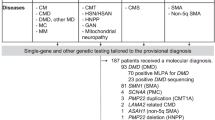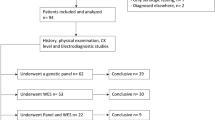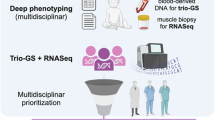Abstract
Next-generation sequencing (NGS) gene-panel-based analyses constitute diagnosis strategies which are adapted to the genetic heterogeneity within the field of myopathies, including more than 200 implicated genes to date. Nonetheless, important inter-laboratory diversity of gene panels exists at national and international levels, complicating the exchange of data and the visibility of the diagnostic offers available for referring neurologists. To address this issue, we here describe the initiative of the genetic diagnosis section of the French National Network for Rare Neuromuscular Diseases (Filière Nationale des Maladies Rares Neuromusculaires, FILNEMUS), which led to set up a consensual nationwide diagnostic strategy among the nine French genetic diagnosis laboratories using NGS for myopathies. The strategy is based on the determination of 13 clinical and/or histological entry-diagnosis groups, and consists for each group either in a successive NGS analysis of a “core gene list” followed in case of a negative result by the analysis of an “exhaustive gene list”, or in the NGS analysis of a “unique exhaustive gene list”.
Similar content being viewed by others
Log in or create a free account to read this content
Gain free access to this article, as well as selected content from this journal and more on nature.com
or
References
Bonne G, Rivier F, Hamroun D. The 2018 version of the gene table of monogenic neuromuscular disorders (nuclear genome). Neuromuscul Disord. 2017;27:1152–83.
Matthijs G, Souche E, Alders M, Corveleyn A, Eck S, Feenstra I,et al. Guidelines for diagnostic next-generation sequencing. Eur J Hum Genet. 2016;24:2–5.
Strande NT, Riggs ER, Buchanan AH, Ceyhan-Birsoy O, DiStefano M, Dwight SS, et al. Evaluating the clinical validity of gene-disease associations: an evidence-based framework developed by the clinical genome resource. Am J Hum Genet. 2017;100:895–906.
Acknowledgements
We sincerely thank Shahram Attarian, Christine Barnerias, Marc Bartoli, Anthony Behin, Claude Cances, Jean-Marie Cuisset, Andoni Echaniz-Laguna, Bruno Eymard, Svetlana Gorokhova-Devred, Pascal Laforet, Nicolas Levy, Armelle Magot, Philippe Petiot, Susana Quijano Roy, François Rivier, Sabrina Sacconi, Tanya Stojkovic, and Guilhem Sole for their contribution in reviewing the definite gene list documents. We sincerely thank Anne Barlier, Gisèle Bonne, Claude Jardel, Delphine Lacourt, Philippe Latour, Vincent Procaccio, Pascale Richard, and Pascale Saugier-Veber for organizational discussions.
This study was supported by the Filière Nationale des Maladies Rares Neuromusculaires FILNEMUS, AFM-TELETHON, and by a Grant FP7/2007-2013 from the European Community Seventh Framework Program (Grant Agreement No. 2012-305121) “Integrated European omics research project for diagnosis and therapy in rare neuromuscular and neurodegenerative diseases” (NEUROMICS).
Author information
Authors and Affiliations
Corresponding author
Ethics declarations
Conflict of interest
The authors declare that they have no conflict of interest.
Electronic supplementary material
Rights and permissions
About this article
Cite this article
Krahn, M., Biancalana, V., Cerino, M. et al. A National French consensus on gene lists for the diagnosis of myopathies using next-generation sequencing. Eur J Hum Genet 27, 349–352 (2019). https://doi.org/10.1038/s41431-018-0305-1
Received:
Revised:
Accepted:
Published:
Issue date:
DOI: https://doi.org/10.1038/s41431-018-0305-1
This article is cited by
-
System-level analysis of genes mutated in muscular dystrophies reveals a functional pattern associated with muscle weakness distribution
Scientific Reports (2024)
-
French recommendations for the management of glycogen storage disease type III
European Journal of Medical Research (2023)
-
Clinical and functional characterization of a long survivor congenital titinopathy patient with a novel metatranscript-only titin variant
Acta Neuropathologica Communications (2023)
-
First characterization of congenital myasthenic syndrome type 5 in North Africa
Molecular Biology Reports (2021)
-
A new tool CovReport generates easy-to-understand sequencing coverage summary for diagnostic reports
Scientific Reports (2020)



